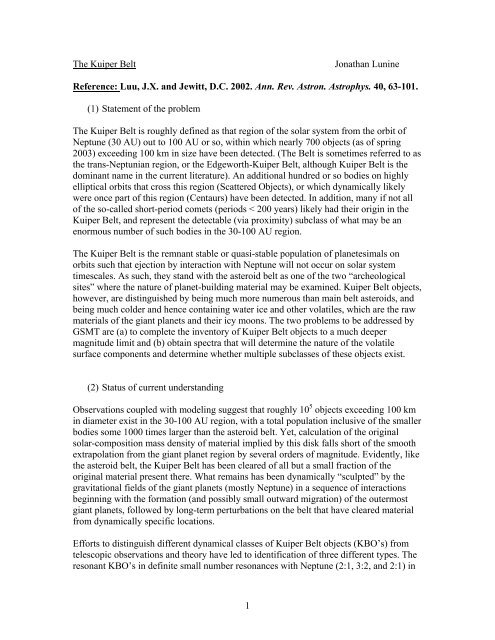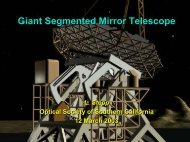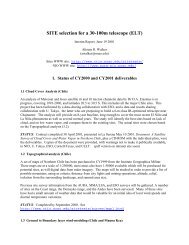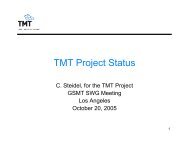You also want an ePaper? Increase the reach of your titles
YUMPU automatically turns print PDFs into web optimized ePapers that Google loves.
The <strong>Kuiper</strong> <strong>Belt</strong><br />
Jonathan Lunine<br />
Reference: Luu, J.X. and Jewitt, D.C. 2002. Ann. Rev. Astron. Astrophys. 40, 63-101.<br />
(1) Statement of the problem<br />
The <strong>Kuiper</strong> <strong>Belt</strong> is roughly defined as that region of the solar system from the orbit of<br />
Neptune (30 AU) out to 100 AU or so, within which nearly 700 objects (as of spring<br />
2003) exceeding 100 km in size have been detected. (The <strong>Belt</strong> is sometimes referred to as<br />
the trans-Neptunian region, or the Edgeworth-<strong>Kuiper</strong> <strong>Belt</strong>, although <strong>Kuiper</strong> <strong>Belt</strong> is the<br />
dominant name in the current literature). An additional hundred or so bodies on highly<br />
elliptical orbits that cross this region (Scattered <strong>Objects</strong>), or which dynamically likely<br />
were once part of this region (Centaurs) have been detected. In addition, many if not all<br />
of the so-called short-period comets (periods < 200 years) likely had their origin in the<br />
<strong>Kuiper</strong> <strong>Belt</strong>, and represent the detectable (via proximity) subclass of what may be an<br />
enormous number of such bodies in the 30-100 AU region.<br />
The <strong>Kuiper</strong> <strong>Belt</strong> is the remnant stable or quasi-stable population of planetesimals on<br />
orbits such that ejection by interaction with Neptune will not occur on solar system<br />
timescales. As such, they stand with the asteroid belt as one of the two “archeological<br />
sites” where the nature of planet-building material may be examined. <strong>Kuiper</strong> <strong>Belt</strong> objects,<br />
however, are distinguished by being much more numerous than main belt asteroids, and<br />
being much colder and hence containing water ice and other volatiles, which are the raw<br />
materials of the giant planets and their icy moons. The two problems to be addressed by<br />
GSMT are (a) to complete the inventory of <strong>Kuiper</strong> <strong>Belt</strong> objects to a much deeper<br />
magnitude limit and (b) obtain spectra that will determine the nature of the volatile<br />
surface components and determine whether multiple subclasses of these objects exist.<br />
(2) Status of current understanding<br />
Observations coupled with modeling suggest that roughly 10 5 objects exceeding 100 km<br />
in diameter exist in the 30-100 AU region, with a total population inclusive of the smaller<br />
bodies some 1000 times larger than the asteroid belt. Yet, calculation of the original<br />
solar-composition mass density of material implied by this disk falls short of the smooth<br />
extrapolation from the giant planet region by several orders of magnitude. Evidently, like<br />
the asteroid belt, the <strong>Kuiper</strong> <strong>Belt</strong> has been cleared of all but a small fraction of the<br />
original material present there. What remains has been dynamically “sculpted” by the<br />
gravitational fields of the giant planets (mostly Neptune) in a sequence of interactions<br />
beginning with the formation (and possibly small outward migration) of the outermost<br />
giant planets, followed by long-term perturbations on the belt that have cleared material<br />
from dynamically specific locations.<br />
Efforts to distinguish different dynamical classes of <strong>Kuiper</strong> <strong>Belt</strong> objects (KBO’s) from<br />
telescopic observations and theory have led to identification of three different types. The<br />
resonant KBO’s in definite small number resonances with Neptune (2:1, 3:2, and 2:1) in<br />
1
orbits with semi-major axes from 36 to 48 AU, and modest eccentricities. Those orbiting<br />
in the 3:2 resonance are most numerous, and are called Plutinos after the largest-known<br />
member, Pluto. All these bodies have perihelia with 30 AU, and hence cross the orbit of<br />
Neptune. Their stability depends on being in resonance with Neptune, phased so that<br />
close-encounter and ejection does not occur. They are the remnant of a larger population<br />
not so gifted with the right orbital elements. The classical KBO’s comprise roughly 2/3<br />
of the known objects in the <strong>Kuiper</strong> <strong>Belt</strong>, are defined as having semi-major axes between<br />
42 and 48 AU, small eccentricities and perihelia beyond 35 AU. The scattered KBO’s are<br />
a minority in the observable belt but could be as numerous as the classical KBO’s. They<br />
have large eccentricity, large inclination and may represent a population of material<br />
originally near to Uranus and Neptune but then scattered outward by these giant planets.<br />
Many more may exist beyond 50 AU semi-major axis but are simply not observable with<br />
present telescope technology.<br />
The current picture of the structure and evolution of the <strong>Kuiper</strong> <strong>Belt</strong> suffers from a<br />
number of ambiguities associated with observational limitations. (I) We do not know<br />
unambiguously the physical sizes of all but the largest two or three <strong>Kuiper</strong> <strong>Belt</strong> objects<br />
because we cannot resolve their disks nor separately measure their albedos. It is<br />
necessary to detect the thermal infrared signatures of these bodies, or directly resolve<br />
disks with larger telescopic/AO systems, in order to determine physical radii. The sizefrequency<br />
distribution of the various KBO populations is an important constraint on the<br />
evolution of the <strong>Kuiper</strong> <strong>Belt</strong>, because it is a result of processes such as accretion and<br />
collisional grinding-down of bodies. Determining a different size-frequency distribution<br />
for the classical and resonance bodies versus the bodies in the scattered disk would be of<br />
extreme importance and might tightly constrain the origin of the scattered disk.<br />
(II) The classical disk seems to be truncated at around 50 AU; that is, bodies with semimajor<br />
axes smaller than that value not associated with the scattered disk seem to be<br />
absent. This seems not to be an observational effect, unless the typical sizes of objects or<br />
their albedos decline significantly beyond 50 AU. More plausible is that the classical disk<br />
is truncated, but it is unclear how or when this happened. Much deeper surveys with more<br />
sensitive telescopes could more severely test the inference that the disk truncates beyond<br />
50 AU, as well as search for objects in the scattered disk to a level of completeness not<br />
possible with current systems.<br />
(III) Disagreement exists over whether the distributions of colors among KBO’s<br />
represents a random and smooth variation, or whether there are distinct classes (i.e.,<br />
dark/red and bright/neutral)—and further, whether the distinct classes are correlated with<br />
the dynamical classes. This issue could be partly resolved through more sensitive<br />
photometry, and the independent detection of a thermal signature enabling the albedo to<br />
be extracted from the brightness in the optical. Regardless of whether there are two or<br />
more “color” classes of <strong>Kuiper</strong> <strong>Belt</strong> objects, the existence of broad color variations is<br />
itself interesting. Absent other processes, the cosmic ray bombardment of a <strong>Kuiper</strong> <strong>Belt</strong><br />
object will tend to darken its surface and, if organics are present, make it very red and<br />
very dark. A bright neutrally-colored surface suggests some resurfacing process, perhaps<br />
collisions that flake off the dark crust to expose fresh water ice, methane, ammonia,<br />
2
nitrogen, etc., to space. Pluto, and even more so Triton (likely a KBO captured by<br />
Neptune early in the history of the solar system), exhibit bright areas that are the result of<br />
seasonal resurfacing by volatile ices as the subsolar point moves across their surfaces.<br />
Smaller KBO’s may not be able to stably retain the vapors of volatile ices like methane<br />
and nitrogen, but exposure by collision of new pockets could be followed by cycles of<br />
sublimation and condensation with progressive removal of the exposed material, along<br />
with cosmic-ray-induced darkening. Unfortunately, near-infrared spectra to determine the<br />
presence of hydrocarbons, nitrogen-based compounds and water ice is extremely difficult<br />
given the small sizes and distances of KBO’s. Only Pluto, its moon Charon, Triton, and a<br />
couple of smaller KBO’s show spectral features, and only on the first three can<br />
quantitative analysis of surface composition be made—even at the world’s largest<br />
existing telescopes.<br />
(IV) Comparison of the composition of the surface ices on bright <strong>Kuiper</strong> <strong>Belt</strong> objects is<br />
crucial if we are to connect the short-period comets to an origin in the <strong>Kuiper</strong> <strong>Belt</strong>. Also,<br />
comparative spectra of grains in comets and extrasolar disks that are remnants of planet<br />
formation weakly suggest compositional similarities. Since the <strong>Kuiper</strong> <strong>Belt</strong> itself is a<br />
better analog for the dust producing material in such disks than are the individually<br />
scattered comets (which are extremely evolved dynamically), similar comparisons<br />
between disks and KBO’s are highly desirable—but will require very large telescopes for<br />
the KBO spectra.<br />
(3) Description of key measurements needed<br />
Here the key measurements required are organized along the lines of the four problems<br />
(I,II,III) described above.<br />
(I)<br />
(II)<br />
(III)<br />
Detection of thermal infrared signatures of KBO’s will be difficult for GSMT,<br />
especially compared to space-based cold telescopes like JWST, but GSMT<br />
might determine directly albedos for some of the nearer KBO’s by direct AO<br />
detection of the disk. Thus both high precision AO and infrared measurements<br />
on individual objects are desirable with GSMT.<br />
Deep optical surveys of the <strong>Kuiper</strong> <strong>Belt</strong> to detect more distant, and smaller<br />
objects, will be a key capability of the GSMT. Long exposures to achieve V<br />
magnitudes of XX so as to detect a 10 km, albedo 0.1 object at 100 AU are<br />
important, but such pencil-beam surveys may miss objects with unusual<br />
orbital inclinations, and so broader but shallower surveys are desirable as<br />
well. KBO’s with 10-km radius in orbits like those of the 100 km sized bodies<br />
discovered to date will be well within reach of GSMT.<br />
Precision photometry of <strong>Kuiper</strong> <strong>Belt</strong> objects to better constrain colors on<br />
already-measured objects, and to obtain colors on fainter or hitherto unknown<br />
objects, is required to resolve the relationship among color/brightness<br />
/dynamical class. In particular, analyzing color properties for a large cohort of<br />
scattered disk objects will require the high sensitivity of GSMT.<br />
3
(IV)<br />
Spectroscopy in the near-infrared, despite extensive work on Pluto and Triton,<br />
really remains an unexplored frontier for the majority of KBO’s, those<br />
observed to date having no or low S/N features. GSMT’s high sensitivity<br />
should enable R=1000 spectroscopy on small <strong>Kuiper</strong> <strong>Belt</strong> objects. Figure 1<br />
shows a simulated spectrum of a 20 km radius KBO at 30 AU assuming a<br />
surface composition akin to Pluto, for the sake of argument. Corresponding<br />
sensitivities of GSMT are given at three wavelengths for R=1000<br />
spectroscopy/ GSMT can measure the spectrum of this very small object.<br />
Equivalently GSMT can do the same for the 100 km sized bodies more typical<br />
of what is detected today, at larger distances (100 AU) or lesser brightness<br />
than the putative object modeled here.<br />
(4) Comparison with JWST and SIRTF<br />
As cold space borne telescopes, JWST and SIRTF will do a better job than GSMT of<br />
detecting and measuring the thermal infrared signatures of KBO’s, which have<br />
surface temperatures of 30-50 K (or less), and hence Planck peaks in the 60-100<br />
micron region. (Although SIRTF goes to much longer wavelength than JWST, the<br />
latter’s larger mirror aperture makes it more sensitive for these detections).<br />
Conversely, GSMT will be a much better survey instrument for detecting smaller or<br />
more distant KBO’s in the optical than will be either JWST or SIRTF, because of<br />
GSMT’s enormous mirror area. It should also beat either infrared telescope in<br />
obtaining resolved disk observations of closer KBO’s via the large aperture and<br />
advanced AO.<br />
Color photometry with GSMT will likely outshine that of NIRCam (JWST)<br />
photometry, again because of signal to noise. However, spectroscopic capabilities of<br />
GSMT and JWST will be complementary. The high sensitivity of GSMT in the<br />
optical will enable good resolution spectra in the near-IR of objects 1% the radius of<br />
Pluto, but at wavelengths approaching 5 microns these objects will be extremely dark<br />
as a result of the lack of solar flux and the lack of significant thermal flux until the<br />
mid-infrared is reached. The mid-infrared spectra will best be done with MIRI on<br />
JWST, because of the cold space telescope’s enormous depression of the parasitic<br />
infrared background. The mid-infrared spectra of KBO’s, including Pluto and<br />
Charon, are unknown territory; even Voyager 2’s flyby of Triton did not yield such a<br />
spectrum because the infrared instrument onboard was optimized for Jovian and<br />
Saturnian temperatures and was limited to broadband radiometric mapping at Triton.<br />
Thus, such spectra will be exciting in their own right. But the near-IR spectra<br />
obtained from GSMT for KBO’s other than Pluto will likely contain important<br />
surprises, since we really do not know the range of surface compositions that obtain<br />
the <strong>Kuiper</strong> <strong>Belt</strong>. Such spectra, of multiple objects, will permit meaningful<br />
comparisons with cometary and remnant circumstellar disk compositions.<br />
4
0.01<br />
20-km; spectral res. ~ 1000<br />
Measured flux, mjanskys<br />
0.001<br />
0.0001<br />
0.00001<br />
1.0 1.2 1.3 1.5 1.6 1.8 1.9 2.1 2.2 2.4<br />
Wavelength, microns<br />
Figure 1. Model spectrum of a KBO 30 AU from Earth, with radius 20 km and an<br />
overall albedo similar to Pluto’s, plotted as millijansky versus wavelength. The shape<br />
of the spectrum is taken from that of Pluto’s reflectivity versus wavelength, courtesy<br />
John Stansberry, then convolved with the solar flux at 30 AU. KBO’s are expected to<br />
have a wide range of possible spectra; some are known to be relatively featureless and<br />
red. The sensitivity numbers, courtesy M. Mountain, are for a 10 4 second exposure,<br />
S/N=10, with 4 x 4 pixels across the point source and a GSMT emissivity of 10%.<br />
5







